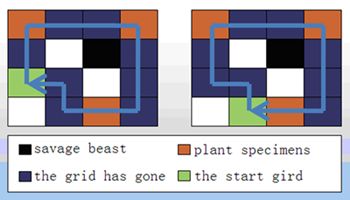fzu 1977 Pandora adventure(插头DP一条回路 格子的占用或不占用)
Accept: 244 Submit: 813
Time Limit: 1000 mSec Memory Limit : 32768 KB
 Problem Description
Problem Description
The pollution of the earth is so serious that people can not survive any more. Fortunately, people have found a new planet that maybe has life, and we call it "Pandora Planet".
Leonardo Da Vinci is the only astronaut on the earth. He will be sent to the Pandora Planet to gather some plant specimens and go back. The plant specimen is important to the people to decide whether the planet is fit to live or not.
Assuming that Da Vinci can only move in an N×M grid. The positions of the plant specimens he wants to collect are all marked by the satellite. His task is to find a path to collect all the plant specimens and return to the spaceship. There are some savage beasts in the planet. Da Vinci can not investigate the grid with the savage beast. These grids are also marked by the satellite. In order to save time Da Vinci could only visit each grid exactly once and also return to the start grid, that is, you can not visit a grid twice except the start grid. You should note that you can choose any grid as the start grid.
Now he wants to know the number of different paths he can collect all the plant specimens. We only care about the path and ignore where the start grid is, so the two paths in Figure 1 are considered as the same.
 Figure 1
Figure 1
 Input
Input
The first line of the input contains an integer T (T≤100), indicating the number of cases. Each case begins with a line containing two integers N and M (1≤N, M≤12), the size of the planet is N×M. Each of the following N lines contains M characters Gij(1≤i≤N, 1≤j≤M), Gij denotes the status of the grid in row i and column j, where 'X' denotes the grid with savage beast, '*' denotes the safe grid that you can decide to go or not, 'O' denotes the plant specimen you should collect. We guarantee that there are at least three plant specimens in the map.
 Output
Output
For each test case, print a line containing the test case number (beginning with 1) and the number of different paths he can collect all the plant specimens. You can make sure that the answer will fit in a 64-bit signed integer.
 Sample Input
Sample Input
 Sample Output
Sample Output
 Source
Source
The 35th ACM/ICPC Asia Regional Fuzhou Site —— Online Contest
题意:给你一个地图,地图上有些资源,还有一些不可走的格子,找到一条回路,使得所有资源被收集,每次只能通过格子一次。。。。
分析:看似比较复杂,仔细想想还是简单的插头DP一条回路,对于不必须去的格子,多加一个空插头是也可以直接下传状态就行,还有,判断合并的条件是当前的格子在所有资源的后面。。。也就是已经收集了所有资源才可以合并,并且状态不下传。。
貌似有点慢240ms++
代码:
#include<cstdio>
#include<cstring>s
#include<iostream>
using namespace std;
const int mm=100007;
typedef long long LL;
struct hashMap
{
int h[mm],s[mm],p[mm],t;
LL v[mm];
void push(int w,LL val)
{
int i,id=w%mm;
for(i=h[id];i>=0;i=p[i])
if(s[i]==w)
{
v[i]+=val;
return;
}
v[t]=val,s[t]=w,p[t]=h[id],h[id]=t++;
}
void clear()
{
t=0,memset(h,-1,sizeof(h));
}
}f[2];
int g[22][22];
int i,j,k,g1,g2,n,m,en,em,t,cs=0;
LL ans;
char c;
bool ok(int s)
{
if(s==1)return g[i+1][j];
if(s==2)return g[i][j+1];
return g[i+1][j]&&g[i][j+1];
}
int Link(int s,int flag)
{
int n=1,w,x=3<<(j<<1),a=(2-flag)<<(j<<1);
while(n)
{
if(flag)a<<=2,x<<=2;
else a>>=2,x>>=2;
w=s&x;
if(w)n+=(w==a)?1:-1;
}
return s^x;
}
void Work(int s,LL val)
{
int e,w=j<<1,x=(s>>w)&15;
if(x==9)
{
if((i>en||(i==en&&j>=em))&&!(s^(x<<w)))ans+=val;
}
else if(!x)
{
if(ok(3))f[g2].push(s^(9<<w),val);
if(g[i][j]==1)f[g2].push(s,val);
}
else if(!(x&3)||!(x&12))
{
if(x&3)e=0,x|=x<<2;
else e=1,x|=x>>2;
if(ok(1+e))f[g2].push(s,val);
if(ok(1+!e))f[g2].push(s^(x<<w),val);
}
else if(x==6)f[g2].push(s^(x<<w),val);
else f[g2].push(Link(s^(x<<w),x==5),val);
}
void end()
{
for(en=n-1;en>=0;--en)
for(em=m-1;em>=0;--em)
if(g[en][em]==2)return;
}
void PlugDP()
{
end();
f[0].clear();
f[0].push(0,1);
for(ans=g2=i=0;i<n;++i)
{
for(k=0;k<f[g2].t;++k)f[g2].s[k]<<=2;
for(j=0;j<m;++j)
if(g[i][j])for(g1=g2,g2=!g2,f[g2].clear(),k=0;k<f[g1].t;++k)
Work(f[g1].s[k],f[g1].v[k]);
}
}
int main()
{
scanf("%d",&t);
while(t--)
{
memset(g,0,sizeof(g));
scanf("%d%d",&n,&m);
for(i=0;i<n;++i)
for(j=0;j<m;++j)
scanf(" %c",&c),g[i][j]=(c=='X')?0:((c=='*')?1:2);
PlugDP();
printf("Case %d: %I64d\n",++cs,ans);
}
return 0;
}